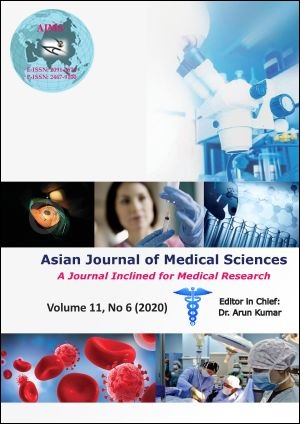Clinical and laboratory profile of Scrub typhus in paediatric age group
Keywords:
Capillary leak, Fever Lymphadenopathy, Myocarditis, Scrub typhusAbstract
Background: Scrub typhus is an acute febrile illness caused by Orientia tsutsugamushi, obligate intracellular organism. Incidence of Scrub typhus is increasing due to easy availability and decreased cost of diagnostic facility. This study was designed to study the clinical and laboratory profile of scrub typhus patient in department of paediatrics at National Medical College, Birgunj.
Aims and Objectives: To study the clinical manifestations, laboratory findings and complications of Scrub typhus in Pediatric age group.
Methods and Methods: A prospective observational study was carried out in children below the age of 15 years, admitted in paediatrics department of a tertiary care hospital of Nepal from June 2019 to May 2020. Clinical manifestations and laboratory findings were collected and recorded in predesigned data sheet. Scrub typhus was diagnosed with IgM ELISA.
Results: A total of 52 patients were diagnosed as scrub typhus. All patients presented with fever and commonly had other symptoms such as headache (65.3%), vomiting (63.5%), cough (59.6%), breathing difficulty (57.7%), abdominal pain (53.9%), seizures (21.2%) and rashes (9.6%). Important clinical signs noticed were lymphadenopathy (84.6%), edema (76.4%), hepatomegaly (56.8%), splenomegaly (36.5%) jaundice (30.7%). About 12% (n = 9) had necrotic eschar. 54% of the admitted patient confirmed using open defecation. Myocarditis (67.3%) was the commonest complication followed by Acute Kidney Injury (65.4%).
Conclusions: Scrub typhus must be considered in differential of tropical fever in children, especially in those residing in rural area and having open defecation. In our study, Fever was the ubiquitous symptom and Myocarditis was the commonest complication.
Downloads
Downloads
Published
How to Cite
Issue
Section
License
Authors who publish with this journal agree to the following terms:
- The journal holds copyright and publishes the work under a Creative Commons CC-BY-NC license that permits use, distribution and reprduction in any medium, provided the original work is properly cited and is not used for commercial purposes. The journal should be recognised as the original publisher of this work.
- Authors are able to enter into separate, additional contractual arrangements for the non-exclusive distribution of the journal's published version of the work (e.g., post it to an institutional repository or publish it in a book), with an acknowledgement of its initial publication in this journal.
- Authors are permitted and encouraged to post their work online (e.g., in institutional repositories or on their website) prior to and during the submission process, as it can lead to productive exchanges, as well as earlier and greater citation of published work (See The Effect of Open Access).




